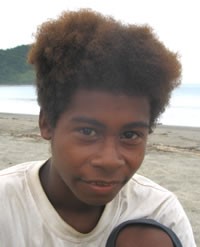Agta, Dupaninan in Philippines

Photo Source:
Anonymous
|
Send Joshua Project a map of this people group.
|
| People Name: | Agta, Dupaninan |
| Country: | Philippines |
| 10/40 Window: | No |
| Population: | 2,000 |
| World Population: | 2,000 |
| Primary Language: | Agta, Dupaninan |
| Primary Religion: | Ethnic Religions |
| Christian Adherents: | 10.00 % |
| Evangelicals: | 3.00 % |
| Scripture: | New Testament |
| Ministry Resources: | Yes |
| Jesus Film: | No |
| Audio Recordings: | No |
| People Cluster: | Filipino, Tribal |
| Affinity Bloc: | Malay Peoples |
| Progress Level: |
|
Introduction / History
The original inhabitants of the Philippines were small black people, now called "negritos." Around 2,000 years ago the ancestors of most Filipinos came to the Philippines from what is now Malaysia and/or Indonesia. They overran the original inhabitants such that today the "negritos" consist of an extremely tiny portion of the Philippine population of over 80 million people, and they live in very marginal and/or remote areas. There are about a dozen such people groups that have their own totally distinct languages, cultures, and geographic areas. The East Cagayan Agta (or Dupaninan Agta) is one of these. The Dupaninan Agta might possibly be the most remote/isolated of these groups. There are perhaps 1000-2000 of them, but that is a very rough estimate at best.
Where Are they Located?
The Dupaninan Agta live in the north-eastern Philippines, specifically in the eastern part of Cagayan Province, and the north-eastern part of Isabella province. Most are semi-nomadic, and all live near rivers. The areas they live in are one of the few remaining sizable rain-forested areas in the Philippines, and have an extremely low population. Most live in very small communities of perhaps a couple dozen people. The Dupaninan Agta have an egalitarian society, with no formal leaders. Typically, if a couple of leading men in a community get into a conflict, the community will split, and half will go live elsewhere.
What Are Their Lives Like?
The Dupaninan Agta do some limited agriculture, and they are also hunter-gatherers in their rain forest habitat in the remote northeastern corner of Luzon. Most of their hunting is with bow and arrow. But their previous way of life and ability to provide for themselves in the traditional ways is quickly coming to an end. The country is already mostly deforested, and with the rapidly expanding population and the logging that is going on, they will not be able to continue in their old ways for long. The East Cagayan Agta have an extremely low life expectancy, which is partly due to a very high infant mortality rate. The infant mortality is so high that they do not even name babies unless they survive to be two years old. Tuberculosis, malaria and dengue fever are common as well. The Agta have a low literacy rate, especially given the fact that the Philippines has very high.
What Are Their Beliefs?
The Dupaninan Agta are traditionally animists, having no formal religion, but rather, fear of spirits. In the 1990s a small number started becoming Christians, and there are over 100 Christians now. The large majority of the Agta are still animists.
What Are Their Needs?
They have large needs in terms of health, literacy, and education. They have large spiritual needs as well.
Prayer Points
For health: reduction in tuberculosis, malaria, dengue fever, and water-borne illnesses.
For their education and literacy to improve.
For spiritual growth for the Dupaninan Agta as a whole.
For protection, health, boldness, and effectiveness in serving for existing believers and leaders.